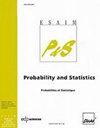Invariant measures of interacting particle systems: Algebraic aspects
IF 0.7
4区 数学
Q4 STATISTICS & PROBABILITY
引用次数: 1
Abstract
Consider a continuous time particle system ηt = (ηt(k), k ∈ 𝕃), indexed by a lattice 𝕃 which will be either ℤ, ℤ∕nℤ, a segment {1, ⋯ , n}, or ℤd, and taking its values in the set Eκ𝕃 where Eκ = {0, ⋯ , κ − 1} for some fixed κ ∈{∞, 2, 3, ⋯ }. Assume that the Markovian evolution of the particle system (PS) is driven by some translation invariant local dynamics with bounded range, encoded by a jump rate matrix ⊤. These are standard settings, satisfied by the TASEP, the voter models, the contact processes. The aim of this paper is to provide some sufficient and/or necessary conditions on the matrix ⊤ so that this Markov process admits some simple invariant distribution, as a product measure (if 𝕃 is any of the spaces mentioned above), the law of a Markov process indexed by ℤ or [1, n] ∩ ℤ (if 𝕃 = ℤ or {1, …, n}), or a Gibbs measure if 𝕃 = ℤ/nℤ. Multiple applications follow: efficient ways to find invariant Markov laws for a given jump rate matrix or to prove that none exists. The voter models and the contact processes are shown not to possess any Markov laws as invariant distribution (for any memory m). (As usual, a random process X indexed by ℤ or ℕ is said to be a Markov chain with memory m ∈ {0, 1, 2, ⋯ } if ℙ(Xk ∈ A | Xk−i, i ≥ 1) = ℙ(Xk ∈ A | Xk−i, 1 ≤ i ≤ m), for any k.) We also prove that some models close to these models do. We exhibit PS admitting hidden Markov chains as invariant distribution and design many PS on ℤ2, with jump rates indexed by 2 × 2 squares, admitting product invariant measures.相互作用粒子系统的不变测度:代数方面
考虑一个连续时间粒子系统ηt = (ηt(k), k∈),由一个晶格索引,它将是一个区间{1,⋯n},或者是一个区间{1,⋯n},或者是一个区间{1,⋯n},并且取它在集合ekk𝕃where中的值对于一些固定的κ∈{∞,2,3,⋯},ekk ={0,⋯k−1}。假设粒子系统(PS)的马尔可夫演化是由一些有界范围的平移不变局部动力学驱动的,用跳跃率矩阵来编码。这些都是标准设置,符合TASEP,选民模型,接触过程。本文的目的是提供矩阵上的一些充分和/或必要条件,使得这个马尔可夫过程允许一些简单不变分布,作为乘积测度(如果是上述任何一个空间),一个以0或[1,n]∩0(如果 = 0或{1,…,n})为索引的马尔可夫过程的定律,或一个吉布斯测度,如果 = 0 /n 0。以下是多种应用:为给定跳跃率矩阵找到不变马尔可夫定律或证明不存在马尔可夫定律的有效方法。选民模型和接触过程被证明不具有任何马尔可夫定律作为不变分布(对于任何存储器m)。(通常,一个随机过程X被称为一个马尔可夫链,其存储器m∈{0,1,2,⋯},如果对于任何k,∈a (Xk∈a | Xk−i, i≥1)=²(Xk∈a | Xk−i, 1≤i≤m)。)我们还证明了一些接近这些模型的模型可以。我们展示了承认隐马尔可夫链为不变量分布的PS,并设计了许多跳跃率以2 × 2平方为索引,承认乘积不变量的PS。
本文章由计算机程序翻译,如有差异,请以英文原文为准。
求助全文
约1分钟内获得全文
求助全文
来源期刊

Esaim-Probability and Statistics
STATISTICS & PROBABILITY-
CiteScore
1.00
自引率
0.00%
发文量
14
审稿时长
>12 weeks
期刊介绍:
The journal publishes original research and survey papers in the area of Probability and Statistics. It covers theoretical and practical aspects, in any field of these domains.
Of particular interest are methodological developments with application in other scientific areas, for example Biology and Genetics, Information Theory, Finance, Bioinformatics, Random structures and Random graphs, Econometrics, Physics.
Long papers are very welcome.
Indeed, we intend to develop the journal in the direction of applications and to open it to various fields where random mathematical modelling is important. In particular we will call (survey) papers in these areas, in order to make the random community aware of important problems of both theoretical and practical interest. We all know that many recent fascinating developments in Probability and Statistics are coming from "the outside" and we think that ESAIM: P&S should be a good entry point for such exchanges. Of course this does not mean that the journal will be only devoted to practical aspects.
 求助内容:
求助内容: 应助结果提醒方式:
应助结果提醒方式:


